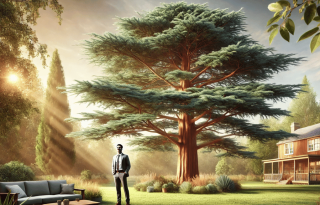Deodar cedar trees are beautiful evergreens. They add elegance to any landscape. Native to the Himalayas, they are known for their graceful, drooping branches. But how can you tell if you have a deodar cedar in your yard? Let’s break it down.
How to Identify a Deodar Cedar
Deodar cedars are tall trees. They can grow up to 70 feet in height. Their branches spread wide, sometimes up to 40 feet. These trees have a pyramid-like shape. Over time, their top may droop, giving them a unique appearance. The needles, cones, and bark are key features to look for.
Deodar Cedar Identification by Needles
The needles of a deodar cedar are soft. They are slender and measure 1 to 2 inches long. Their color varies from bluish-green to silvery-green. If you touch the needles, they won’t feel prickly. Instead, they are flexible and slightly curved. The needles grow in clusters of 20 to 30, making the tree appear dense and lush.
What Do Deodar Cedar Cones Look Like?
Deodar cedar cones are oval-shaped. They are about 3 to 5 inches long. When they first form, they are green. As they mature, they turn light brown. The cones grow upright on the branches, unlike pine cones that hang down. After the cones release their seeds, they disintegrate, leaving behind a woody base.
Deodar Cedar Tree Bark
The bark of a deodar cedar is another way to identify it. When the tree is young, the bark is smooth and gray. As it ages, the bark becomes rough and develops vertical cracks. These cracks give the tree a rugged texture. Over time, the bark may appear reddish-brown.
How to Care for Deodar Cedar
Deodar cedars are low-maintenance trees. However, proper care ensures they stay healthy.
- Planting Location: Choose a spot with full sun. Deodar cedars need at least six hours of sunlight daily. They also prefer well-drained soil.
- Watering: These trees are drought-tolerant once established. Water young trees regularly to help their roots grow strong. Mature trees need watering only during long dry spells.
- Pruning: Prune dead or damaged branches in late winter or early spring. Avoid heavy pruning, as it may affect the tree’s shape.
- Fertilizing: Use a balanced fertilizer in the spring to promote growth.
Potential Threats
Even healthy deodar cedars can face threats. Knowing what to watch for helps protect your tree.
Pests
- Aphids: These tiny insects suck sap from the needles. Look for sticky residue (honeydew) on the tree or ground below.
- Bagworms: These pests create cocoons from needles. They can strip the tree of its foliage.
- Bark Beetles: Small holes in the bark may indicate an infestation.
Diseases
- Root Rot: Overwatering can lead to root rot. Symptoms include yellowing needles and stunted growth.
- Needle Blight: This fungal disease causes needles to turn brown and fall off.
Regular inspection can catch these problems early. If you notice signs of pests or disease, act quickly.
Contact Strobert Tree Services
Not sure if you have a deodar cedar? Need help caring for your trees? Strobert Tree Services can assist. Our certified arborists provide expert tree care. We offer inspections, pruning, pest control, and more.
Call us today for a free tree health assessment. Let’s keep your trees beautiful and healthy!











